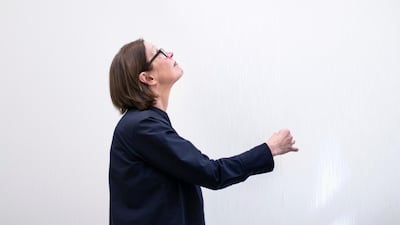Slow down and be silent.
That is what artist Susanna Fritscher compels me to do with her work Fur Die Luft (For the Air). Using thousands of thin silicon threads stretched lengthways on floor-to-ceiling steel frames, she has created a maze-like structure that visitors can enter and meander through at Louvre Abu Dhabi.
From a distance, the transparent threads give the illusion of rain or mist; the light coming in through the glass ceiling adding brightness to the piece. It takes me a moment to find a way into it, as the lines in my periphery overlap with disorienting effect.
“When you come into the gallery, you just see something like a shadow or a light blurring the space,” says Fritscher when I meet her at the museum. “By blurring the space, maybe our sight will be more precise. This is what the work tries to do.”
Experimenting with a variety of materials, Fritscher’s practice plays with perception. These works are not so much optical illusions, but material interventions that make us see our environment in new ways.

Born in Germany and based in France, the artist has been developing her minimalist and monochromatic installations for more than a decade. As in the case of Fur Die Luft, they are often site-specific and reconfigured to the architecture of the space.
When the work was first shown at the Musee d’arts de Nantes in France in 2017, the threads were hung from a high ceiling, framed along the museum’s rectangular skylight. For Louvre Abu Dhabi, Fritscher drew inspiration from Jean Nouvel’s dome and patterned the structure’s base frame after the French architect’s interlocking star-like shapes.
The skylight offers a glimpse of the dome's underside and allows sunlight to filter into the gallery, the strands catching the rays. It is clear that the silicon threads, which Fritscher sources from a single manufacturer in Spain, are a device for the artist to harness an important element – light.
These fragments of light – which appear caught in a web – move and multiply throughout the day, giving the impression that the artwork is always changing. The artist says the hours between 11am and 2pm when the sun is overhead are the best times to view her piece.
The air in the room also has an effect on how it looks. With a thinness of about 0.7 millimetres to 1mm, the threads easily vibrate as people move through the structure, adding a subtle sense of movement to her work.

“The idea is that when you look at this work, you don’t see threads. You see something like a cloud. You forget that they are threads. You see the light, the blurred environment,” says Fritscher.
She describes the way people have reacted to this environment: "My first experience in Nantes is that people slow down, go very quiet inside the space, look where to go, how to advance." It's true. Uncertain of the pathways and aware of the fragility of the threads, I walk slowly, mindfully, almost meditatively.
"When you look at the people inside, they show you the piece. They expose the piece. They make you understand what you see. I think this will happen here, too. It's really like a choreography," she says.
This negotiation between the body and space is part of Fritscher’s work and reflects her preoccupation with architecture and our perception of places. By standing on the outside of the structure and observing how others navigate the space, visitors can observe this “choreography” for themselves.

Fur Die Luft is the last artwork people will encounter before exiting the galleries and stepping out to the atrium, where they find themselves under the dome. Juliette Singer, chief curator of Louvre Abu Dhabi's modern and contemporary art sections, explains this decision, taking into account the museum's chronological display: "When you visit the Louvre, it's like a journey through time. You start from the ancient time and go until now. For me, it's not the end of the journey, it's like an opening to the world of today, towards the architecture of the museum".
“It’s a very universal work. We have audiences coming from China, India, South America, Europe, everywhere. The work becomes a place where they can encounter each other and themselves. You feel your body, your breath, your own spirit,” she says.
Singer came across Fritscher's piece in Nantes two years ago, and decided to bring it to Abu Dhabi for this season's programme, where it will be on display until October 2020. The artist and curator, along with a team of engineers, have been developing the installation, which is on loan from Centre Pompidou, since December.
Due to the delicateness of the threads, only 10 to 12 people will be allowed to enter the structure at a time. I can already imagine some rather precarious situations involving miscalculated steps and running children, but I can also imagine opportunities for reflection, maybe a little calm and awareness after looking at a sequence of various artefacts, tapestries, sculptures, paintings and wall texts from the earlier wings of the museum.
While Fritscher's installation in Nantes was accompanied with a sound piece, the one in Abu Dhabi stands in silence, adding to the quieting effect.

In its simplicity, Fur Die Luft belies the tremendous amount of time, effort and material – 60,000 threads – that have gone into setting it up, but in a way, this is what the artist has set out to do. The clue is in the title. "It can mean 'for the air', but when you say this in German, it also means, 'I did this for nothing'. There is no pathos. It did this without any effect. I did it, just because," she says. "There is a very light sense about it."
Fritscher simply asks us to see and see anew. In a way, she gives museum visitors, and perhaps people in general, what we sometimes need the most – a moment of pause.


